Director: Elvira Reale
Report to Meeting WHO
Women's Mental Health - Priorities and Services
Copenhagen, 5-7 February 2001
by Dr E. Reale, Dr V. Sardelli
International statistics show that psychic pathologies (major depression, anxiety, eating disorders) are prevalent and rising among women within the general population. Depression, specially, is the main cause of burden diseases women between 15 and 44 years of age: the Unipolar Major Depression is at 1st rank in the ten leading causes of female burden of disease in the year 1998. (Source world health report 1999, Database).
Research has highlighted that children's mothers and girls are at the highest risk of depression. The prevalence rates, in depression are between 2 and 3 times higher among women than in men.
The prevalence rates in women compared to men, are clearly rising, starting from adolescence time. Female adolescents run a much higher risk of disease and in some cases, like eating disorders, the rate for women goes up to 9: 1 (90% of the total cases).
Women show a higher rate of neuropsychiatric disorders if compared to men as you can see in this graphic:
![]()
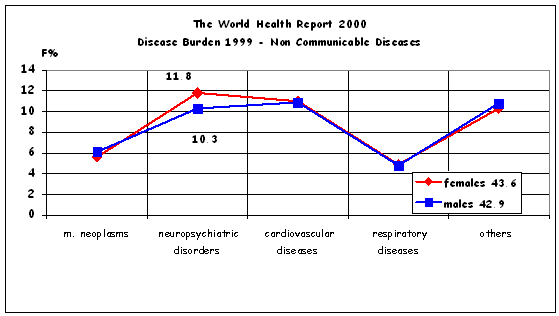
There is evidence that women's cases exceed men's ones in all types of mental disorders, excluding alcoholism and substance abuse, as you can see:
![]()
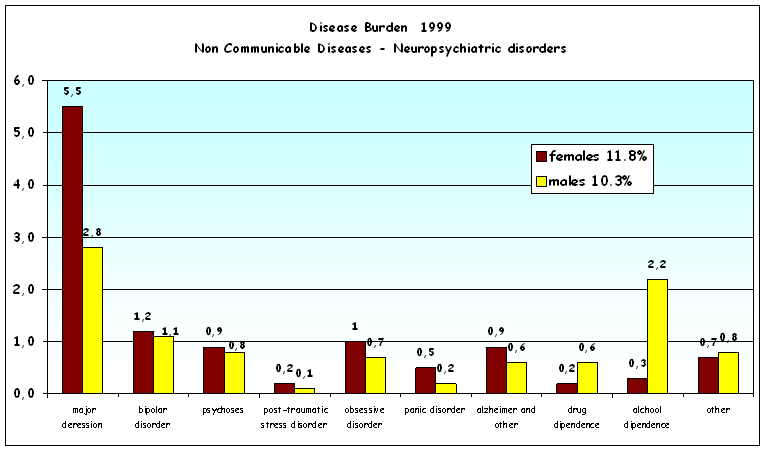
Source: The World Health
Report 2000
These data show an emergency: "Women's Depression" and the necessity to focus on this emergency. The Depression is the pathology with the major difference between women and men.
![]()
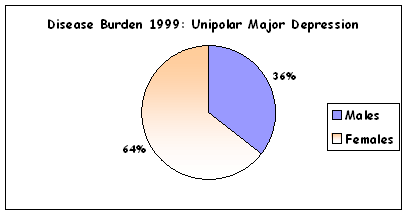
Source: World Health Report 2000
In Italy, the data of National Statistics Board show that women with psychiatric disorders are at the 5th place in the list of chronic diseases, men are at the 8th place.
The
number of women with psychiatric disorders is about twice compared to men's one.
![]()
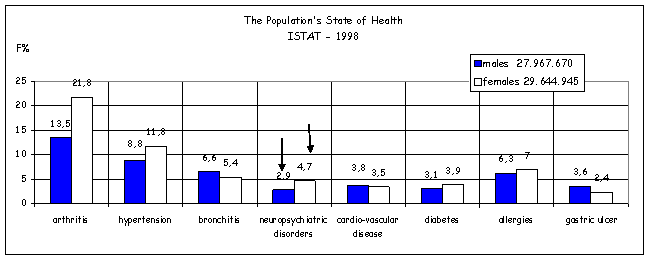
Source: ISTAT - Italian National Statistics Board
In the following graphic you can see that women's prevalence is about 70% compared to men in all psychiatric disorders (10.192.000/ 57.500.000 inhabitants), in Italy.
![]()
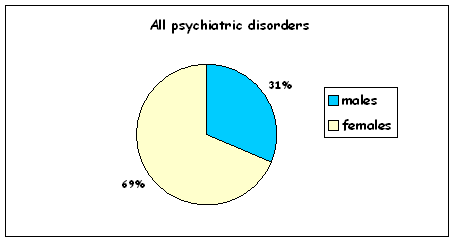
Source: Italian National Health
Institute
As you can see, in all types of mental disorders the rate of women's prevalence is twice or three times compared to men's one. The following data ( table 6) consider comorbidity factors: a single person may suffer from more than one pathology.
![]()
MALES FEMALES
|
All psychiatric disorders |
3.200.000 |
6.992.000 |
|
Affective Disorders Anxiety disorders Eating disorders Adolescence disorders Psychoses Drug abuse |
2.560.000 2.180.000 118.000 24.000 118.000 142.000 |
5.702.361 5.506.000 230.000 204.884 230.494 204.884 |
Source: National Conference on mental Health, January 2001.
Italian data agree with international data regarding women's prevalence over men in almost all mental disorders, particularly women suffer from major depression, dysthymia an anxiety disorders during all lifetime, starting from adolescence.
In Italy 70% of suicides are committed by men, frequently in old age (35%).
Women, between 15-44 years old, attempt suicide more often than men.
Which are the risk factors that might explain the higher rates of mental disorders in females compared to males?
Research pointed out many risk factors as genetic factors, hormonal factors, life events stressors, sex role models, personality structures, etc.
There is evidence that it's difficult to prove genetic, hormonal and personality structure hypotheses. On the contrary, significant data out come from the research on sex role models and psycho-social factors.
Research highlights these risk factors: double work burden, isolation, lack of social support and intimate relationship, low self-esteem.
There is evidence that the amount of pharmacological assumption is rising and women occupy the first place in drugs assumption. In Italy, ISTAT (Italian National Statistics Board) says that there are 5,5 millions of medicines users (psycho medicines particularly anti-depressants); among these, women are 3,7 and men 1,7 millions.
Women in treatment with drugs often experience paradox symptoms and more side effects.
Medical treatment is often ineffective and causes psychological dependence.
There is evidence: several studies on the consequences of violence against women point out psychic damages.
![]()
Particularly they show these consequences:
Health Consequences of violence against women
|
- Depression - Suicidality - Fear, feelings of shame & guilt - Anxiety, panic attacks - Low self-esteem |
- Sexual disfunction - Eating problems - Obsessive-compulsive disorder - Post traumatic stress disorder - abuse of medication, alcohol & drugs |
There is evidence that women have less power than men and bear a higher burden than men.
Women life conditions are worse than men's ones. In spite of differences in social class, all women bear a heavy burden of work and responsibilities due to the double role of mother and worker.
Studies of housework offer important insights into the relationship among role burden, role satisfaction and low self-esteem.
They point out a female "vulnerability" and women 's lifestyles seem to be the most significant explanation of this vulnerability.
2. gender gaps in mental health
It seems like all evidence produced until now in this field didn’t have any effects in the assessment of women’s mental health as a priority problem. We notice the lack of attention toward women’s mental health and the absence of an integrated gender approach
1. in health policies choices;
2. in empirical research, epidemiological and statistics, in etiological research and in the research regarding the effectiveness of drugs;
3. in clinical practices, diagnosis and treatment;
4. in prevention;
5. in health education.
1. Health Policies
Health policies show a deep lack of attention toward women’s health. As examples we want to mention what is considered to be priority
As examples we may mention mental health priorities highlighted by Who and the Italian Ministry of Health.
- Health 21 in "Target 6 - Improving Mental Health" does not indicate the emergency is also around women:
"by the year 2020, people’s psychosocial wellbeing should be improved and better comprehensive services should be available to and accessible by people with mental health problems"[1].
- The Italian health planning does not mention women issues, as in the following schema ( table 8):
Priorities of Psychiatry
1. The stigma of mental disease
2. The family's social-economic disease
3. The split between clinical and social care
4. The good practice in the judicial psychiatric hospitals
5. The mental health in the adolescence
2. The research
In the majority of European states we do not have governmental research programmes for women's mental health.
2.1. The research around aetiology and risk factors
Against all evidence research is mainly oriented to evaluate, in principal way, the correlation between depressive pathology and hormonal and biological factors.
These research projects are carried out with large financial support and with the contribution of pharmaceutical industries, which are profit oriented. Psycho-social research which have contributed to most significant explanation of different rates of depression between women and men do not have adequate financial support.
Mainstream research projects are still problematic because do not study yet the interconnection of many relevant factors: being married and having children; lack of trust toward the partner; lack of social support; low self-esteem; violence, battering and dependency.
Such investigation are not able to offer an etiological model to explain the shift from risk to mental illness among women.
2.2. Pharmacological research
Even though women are greater consumers of drugs there are no studies around differences in pharmacological response among women and men. Experimentation around the effectiveness of drugs is focussed mostly on men and results are often undifferentiated on a gender bases. So women do consume more drugs, with less effectiveness and safety, with respect to men - who are over-represented in clinical and pharmaceutical trials.
2.3. The research on diagnosis criteria and psychiatric treatments
§ Diagnosis
Psychiatric diagnosis is mostly oriented toward symptoms. Life conditions aren't considered aetioopathogenesis.
This allows researchers and health care providers to avoid discussions around psycho-social and environmental causes, which are those mostly connected to the explanation of female mental disease.
Even though women get most of depression diagnosis, psychiatric handbooks[2] do not keep into account the severity of their symptoms from their point of view, since both severity and social relevance are measured with male parameters.
So, typical women's depression marked by "sense of uselessness and incapacity; lack of desire in all fields; block of activities; death drive; unawareness of being into depression" do not constitute indicators of gravity since are not associated with social disfunctioning or higher rate of suicide.
In addition there is another un-acknowledged criterion of gravity related to the effects of a woman's mental disease upon her family life and in particular her children. Recent investigations highlighted mother's depression among negative events in adolescence.
§ B. Treatment
At the level of treatment there are no investigations around new method of intervention aimed to
- observing everyday life (home work, in primis) and behavioural styles;
- changing in everyday organization and response styles connected to disease perception.
Researchers and health care providers do not have high expectations toward women. A rehabilitation enabling women to fulfil mother/wife role expectations seem to be considered enough as an achievement. So, rehab programmes are weak and do not include social skills improvement and personal resources channelling, aimed to elevate self-esteem (whose lack is an important ingredient in the genesis of depression).
3. Clinical practice
In clinical practice we encounter sexual prejudice: the greater diffusion of mental illness, particularly depression, among women, is considered by the majority of psychiatricians as related to female biology (hormonal fluctuation and so on) and psychology (passivity, low self-esteem, dependency).
Treatments for women are comparatively more traditional: pharmaceutical treatment is prevalent, at times associated with psychotherapy.
Women are chosen as targets of innovative psycho-rehab treatments in a lesser extent than men. Such treatments are focussed on male needs toward social skills and productive work.
Treatments in a mixed environment (both in or out clinic) do not fulfil women’s needs: often they are involved in an abusive relationship with a violent male, for they do not appreciate to share a common therapeutical space with men.
Women, with respect to men, are taken care for longer time, are object of longer pharmaceutical treatments and take an higher risk in becoming chronic cases.
This data around longer therapies for women might be due to a lower effectiveness of such treatment, which seem to miss the goal more frequently compared to men in terms of improving women’s health.
4. Prevention
Existing studies did not develop indications for acknowledging risk factors and protective factors in everyday life, to be used in prevention campaigns.
Prevention should have priority in any health system, for any pathology, yet in the field of mental illness we notice a lack of interest in developing studies and indications toward primary prevention. Such a lack of interest damages women in special way, since they are the majority and have many risk factors in their environment.
Improper prevention (often overlapping treatment) is connected to the recommendation to begin drugs assumption as early as possible, i.e., at the first symptom, even during adolescence; to avoid interruptions and to carry out drug assumption for long periods of time.
5. Training
Training programmes do not fit women’s needs. Such programmes do not keep gender differences into account neither in terms of the greater incidence of mental disease nor in terms of educating the medical profession to identify psycho-social risk factors in women’s everyday life.
Training of mental health providers is supported mainly by the pharmaceutical industry, for it shows a greater interest in pharmacological treatment, instead working toward prevention.
6. The organization of services
Mental services focussed on women are very few: most of services ignores women’s health needs in this field and do not wonder around them. In health programmation there are no indication to lower female rates; there are no gender-oriented health activities for risk groups such as adolescent girls or women with job and family commitments or with children.
In synthesis: mental health services seem to correspond to men’s needs, are oriented toward “giving back the person to his activities, in order to restore interrupted activities” without observing if these interrupted activities are the very cause of discomfort and disease.
[1] Health 21 - The Health for All Policy of the WHO European Region - twenty-one targets for the twenty-first century .
[2] American Psychiatric Association (1999) DSM IV Diagnostic and Statistical Manual of mental disorders.
We believe the field of study and research, as well as the field of clinic, are provided with evidences which, up to now, did not result in coherent acts and correcting measures do make clinical treatments and prevention appropriate adapted for women. The measures to be proposed may well be defined in the light of the present state of development of research and of its clear contradictions and gaps. At this stage, it is necessary to work out Directions, Guide Lines and Recommendations useful for the acknowledgement, selection and adoption of appropriate behaviours, both at the clinical and at the research level.
1. The collection of epidemiological and statistical data
Given the importance, in order to build up more reliable risk maps, of having data divided into sex, recommendations to all the European countries to adopt the following measures are necessary:
- standardization of data surveying procedures concerning the personal and social typology of the women who come to mental health services;
- collection of data divided into sex, and presentation of the results according to above distinction.
2. The research
2.1 The research on etiological and risk factors:
Recommendations apt to integrate the gender point of view in the research evaluation criteria are considered necessary.
Highly reliable is considered research:
- using case-control samples;
- including patients of both sexes;
- relating the different variables to the sample divided by sex.
It is right to adopt measures to implement researches apt to offer better results in the perspective of primary prevention.
Researches aimed to:
a. the analysis of risk factors in daily life and in the environment;
b. standardization of the main pre-morbid risk factors in female mental illness, particularly the risk of: family work overload, stress and violence;
c. elaboration of a survey protocol for the gathering of risk factors of mental illness;
d. development of a multicentric European programme on the interaction of the main psycho-social risk factors.
2.2 The research in the field of pharmacology
In this field, it is necessary to acknowledge the difference between women and men in pharmacodynamics, and in pharmacokinetics.
Pharmacological research should assume the goals to improve the efficacy and the safety for women of pharmacological products through:
a. removal of the obstacles to the inclusion of women in clinical and pharmacological trials;
b. data collection trough mix male and female samples;
c. analysis of data divided by sex.
2.3 Research on new diagnostic criteria and tools
It is necessary to modify the diagnostic criteria about the measurement of the social seriousness of discomfort by including the gender point of view. More precisely, the evaluation of seriousness of mental disease could be done on the basis of the perception of impairment and not only on the basis of objective evaluation in terms of social disfunction.
The integration of the gender point of view should be assumed also in the research of new methodologies and new therapeutical tools.
New and specific therapeutical tools for women are necessary, focusing on the link between illness and everyday life, and particularly on the following conditions:
a. the external as well as family work;
b. the use of verbal, psychological and physical violence in both external and family relationships;
c. the educational training to pattern of dependence.
3. The clinical practice: diagnosis and treatment
It is necessary to integrate and modify the traditional ways of health working.
a. Diagnosis
Diagnostic protocols should be widened and should point out the pathogenic route. That is, they should point out the concrete and visible stages of symptom and discomfort developing within everyday life.
b. Pharmacological Treatment
It is necessary to predispose sex specific protocols for pharmacological treatment. Evidences on weight and pharmacodynamic difference should produce recommendations that suggest caution in dosages, lower dosages than for men. Moreover, as long as research is not carried out on both sexes, it is important to investigate, directly from the woman herself, about the side effects produced by pharmaceutical products.
c. Clinical, Medical and Psychological Treatment
The treatment should take into account the evidences brought up by research and in particular of psycho-social risks. It should put the woman to the centre with her every day life difficulties.
All types of intervention should take into account two main factors:
- that many women suffer in daily life of: loneliness, separation, widowhood, unemployment, lack of economical supports , children burden, violence, etc.
- and that many women suffering of anxiety, depression, don't speak about their everyday life difficulties, and don't recognize oppression, violence, fatigue and tiredness.
So it is necessary to work out protocols apt to:
- guide health care providers in singling out the causes undervalued by women themselves;
- give suggestions apt to help women to lighten the burden of responsibilities that benefits others and to assume styles of behaviour more suitable to the individual wellbeing (and benefits herself).
Moreover, homogeneous groups should be set up they should be made up of women sharing, with different symptoms, common life problems, such as: teen ages and post-teen ages, married women with children, separated women etc.
The psyco-social rehabilitation action should be organized around women's needs. The experience with women suggests that these groups may be successfully oriented toward the re-discovery of abilities, expertises and desires for long years set asides and that, instead, can be recovered and included in a personalized and creative social rehabilitation programme.
4. Prevention
A good prevention is one able to single out risk factors, to start up from them the corresponding protection factors and to transfer them in to appropriate information.
Primary prevention should be focused on environmental and social-relational factors. These are factors on which it is possible to intervene before that the overload of pressures becomes a psychic pathology.
As well as any other action and measure, prevention should be gender sensitive and mainly addressed to most vulnerable subjects: female adolescents and women (in the range 15-44).
Prevention consists primarily on giving a correct and wide information on the processes involved in becoming ill and, in the opposite direction, on the protecting factors.
It is addressed to three typologies of subjects:
- The directly concerned persons, that is the target groups represented, as far as psychic pathology is concerned by women in general and particularly by teen ages and young women with family responsibilities.
- The contact groups, that is teachers and parents in the case of teen ages, family members in the case of adult women.
- Health practitioners and specialists in mental health.
We consider important to organize a specific training programme on behalf of general practitioners and other social-health workers, aimed at:
- reducing drug-abuse;
- stimulating a medical and psychological approach apt to explain the connection between illness and everyday life (house work and violent pressure from the family context).
5. Services
It is necessary to direct health services towards:
- preventing and therapeutic activities for women;
- offering women specific services
The main thing is all health care providers work with a gender perspective.
Three types of activity or service for these women:
1. The first type attends to prevent specific situations of distress.
The main goals are to give correct information on links between daily life and mental disease and to transfer means to:
- fight stress, fatigue e tiredness before they become a pathology;
- overcome the pattern of subordination and dependence;
- react against family violence and psychological maltreatment.
In These services could be organized:
a. the listening-centres, the training-stages, the social and psychological support-groups, ecc. Each initiative would be addressed to women with specifical problem:
- Women who have given up working after maternity,
- Women having difficulties in social relationships, in organizing both housework and extra-familiar work;
- Women ill-treated, abused, alcoholic women, etc.
b. Programmes for health education with a view to:
- Increasing women ability to communicate and express themselves emotionally;
- Increasing the ability of analyzing their life-style;
- Improving their image and their self-esteem;
- Reducing the risks of symptoms of mental pathologies.
2. The second type of service is addressed to women who have already begun to develop an illness and manifest symptoms, and who have already had psychiatric treatment.
There women could be encouraged to understand the way in which their daily lives have led them to illness. Work method should be different from that traditionally adopted in psychiatry.
The specialised services should offer practical help and necessary support by creating a concrete alternative to hospitals and to psychiatric cures.
These services have the following goals:
- to reduce or to eliminate the use of specific therapeutical means, such as hospitalization, drugs, or any other strategy that tends to impede or delay the comprehension of the concrete and tangible causes of their illness;
- to consider the symptoms of mental illness as signs of unbearable life conditions;
- to create a new life-style for women's benefits in keeping with their interests, aptitudes and emotions.
3. The third type attend to setting up "women's refuges"
Today, in spite of hospitalization, it his right to consider as a therapeutical tool non medical care places for women with psychological problems.
They could go there spontaneously for receiving psychological support in their daily lives.
So they could make as stop of daily life stressors.
6. European Initiative
We propose the organization, at European level, of a net-work aimed to improve a mental health system oriented on women's problems.
Goals of this net-work can be the following:
- Co-ordination and Promotion of actions focused on women mental health problems.
- Promotion of European Guide-lines and Recommendations.
- Promotion of Services and Projects activities oriented on women's needs.
- Co-ordination and promotion of activities aiming to improve knowledge about gender differences in different fields such as care and treatments, risk factors research, prevention in every day life.
- Development of culture skills based on new approaches and methods to influence women health prevention, diagnosis and treatments.
- Development of training and information contents regarding gender difference in mental health.
- Improving international exchanges of knowledge and experiences.